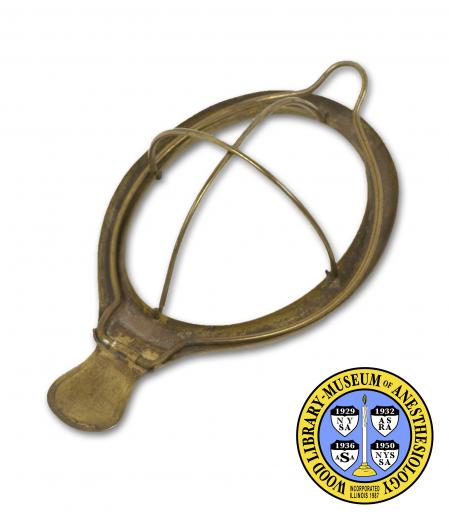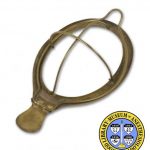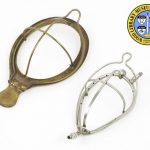Schimmelbusch Mask
Dr. Curt Schimmelbusch (1860-1895), a German physician, designed this mask around 1889 while an assistant surgeon. Surgical assistants were often assigned the task of delivering the anesthetic. During anesthesia it was not uncommon for ether and chloroform to get onto the patient’s skin, causing irritation. Chloroform can even cause burn-like reactions. Schimmelbusch designed the rim of his mask so that both sides curve away from the patient’s face to form a kind of trough. He intended the trough-like rim to collect excess anesthetic that would otherwise have trickled onto the patient’s face.
To anesthetize a patient, gauze was stretched over the metal bars and fastened in place by the hinge. The mask was placed over the patient’s nose and mouth, and the anesthetic was applied in drops or lightly poured onto the gauze so that the patient breathed in evaporated anesthetic as well as air. This type of mask is sometimes still used today for ether anesthesia in developing countries when other means are not available.
Catalog Record: Schimmelbusch Mask
Access Key: aijl
Accession No.: 2010-07-14-7
Title: [Schimmelbusch mask / designed by Curt Schimmelbusch.]
Author: Schimmelbusch, Curt Theodor, 1860-1895.
Title variation: Alt Title
Title: Schimmelbusch-Mask.
Title variation: Alt Title
Title: Schimmelbusch mask, brass.
Title variation: Alt Title
Title: Schimmelbusch’s mask.
Physical Description: 1 oronasal mask : brass ; 18 x 11 x 5.5 cm.
Subject: Masks, Anesthesia – wire frame.
Subject: Anesthesia, Inhalation.
Subject: Chloroform.
Subject: Ether, Ethyl.
Note Type: General
Notes: Title from the WLM name for the artifact.
Note Type: Citation
Notes: Bhargava AK. Early devices for inhalation of ether and chloroform: 1850-1900.
Indian J. Anaesth. 2003;47(3):176-177.
Note Type: Citation
Notes: Duncum BM. The Development of Inhalation Anaesthesia. London: Royal Society
of Medicine Press, 1994:252.
Note Type: Citation
Notes: Maltby JR. Schimmelbusch mask: Curt Schimmelbusch (1860-1895). Notable Names
in Anaesthesia. London: Royal Society of Medicine Press, 2002:190-192.
Note Type: Physical Description
Notes: Brass wire-frame, oronasal mask with an oval-shaped, hinged frame and a
gauze-holding collar; The frame is shaped so that all along the rim there is
a channel, or trough; From a patientís point of reference, two thin bars form
the distal frame of the mask; These curve away from the face to make room for
the nose and mouth; One bar runs laterally through the middle, and the other
runs horizontally through the middle; A single oval, thick brass wire loop is
hinged to the frame at the lower end; This hinged loop acts as a collar or
clamp to hold gauze in place; A clip on the nasal-end holds the wire loop in
place when closed; A small handle is at the oral or chin end of the mask.
Note Type: Reproduction
Notes: Photographed by Mr. William Lyle, 7/14/2010.
Note Type: Historical
Notes: Developed for use with chloroform or ether by the open drop method. When
ether was used, an impermeable outer cover, originally a waxed-cloth, was
used to minimize evaporation (Duncum, 1994). The trough-shaped rim collects
excess anesthetic and prevents anesthetic from dripping onto the patientís
face. The Schimmelbusch mask is still used in some underdeveloped countries
to deliver ether anesthesia (Bhargava, 2003 ; Maltby, 2002). The designer,
Curt Schimmelbusch, was a German physician and pathologist. He designed the
mask while a surgical assistant in 1889.



